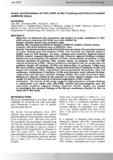| dc.identifier.citation | KAHAKI, DRKIMANI, MARTIN DRKOLLMANNKH. 2009. Listo BN, Kollmann KHM, Kimani K, Owino C.Ocular manifestations of HIV/AIDS at Moi Teaching and Referral Hospital (AMPATH Clinic). East Afr. j. ophthalmol. 2009 Jul; 15(1): 27-34.. African Journal of Midwifery and Womens. : Prof. Anna karani, Prof. Simon Kangethe & Johannes Njagi Njoka | en |
| dc.description.abstract | Objective: To determine the prevalence and pattern of ocular conditions in HIV/AIDS patients attending HIV/AIDS care clinic (AMPATH). Design: Hospital-based cross sectional study. Setting: Moi Teaching and Referral Hospital (AMPATH CLINIC) ,Eldoret, Kenya. Subjects: HIV/AIDS patients seen at AMPATH, clinic.Results: Two hundred patients with HIV/AIDS were examined. The overall prevalence of ocular findings was 154 patients (77%). One hundred and eighteen patients (59%) were on ARV therapy. The main findings were posterior segment lesions (53%), anterior segment disorders (26.5%). Posterior segment findings included; Retinal microvasculopathy (75 patients ,37.5%), chorioretinitis (9 patients ,4.5%), vitreous opacities (8 patients, 4%), macula edema (8 patients, 4%) and CMV retinitis (5 patients ,2.5%). Fibrous membrane attached to the iris mostly near the pupillary margin (37 patients, 18.5%) and iridocyclitis (11 patients, 5.5%) were the main anterior segment findings. Conjunctival growths (13 patients, 6,5%) and Kaposi (10 patients, 5%), conjunctival microvasculopathy (8 patients, 4%) and molluscum contagiosum (5 patients, 2.5%) were the main ocular adnexal findings. Tuberculosis was the main systemic findings (53%). This study found that ocular findings are directly related to the severity of clinical disease staging (e.g. WHO stages III and IV) and severity of immune suppression (CD4+ count). Conclusion: The results of this study suggest a high prevalence of ocular findings in adolescents and adults with HIV/AIDS. Retinal microvasculopathy was the commonest posterior segment finding observed. Further studies are needed to investigate the unusual findings of the fibrous membrane attached to the iris observed in this study | en |

